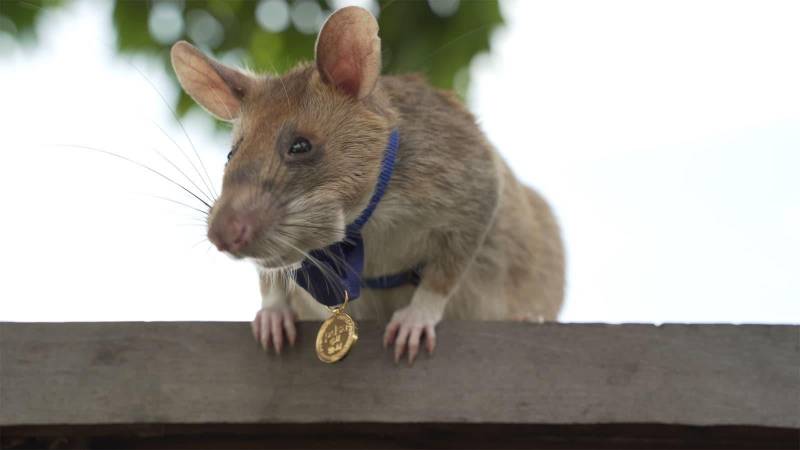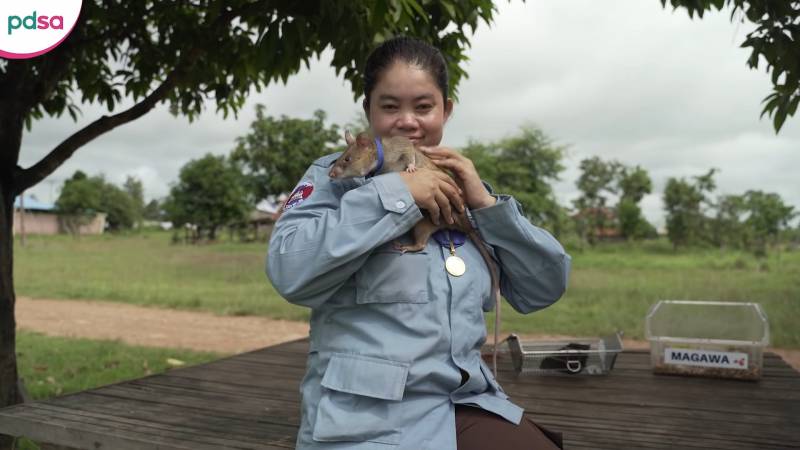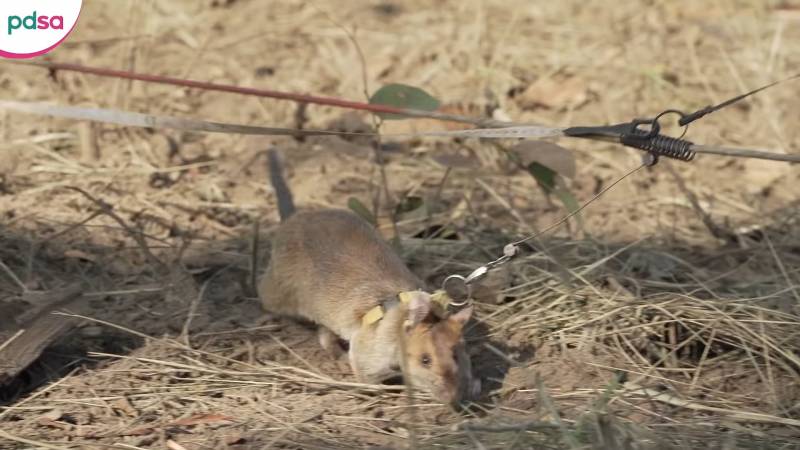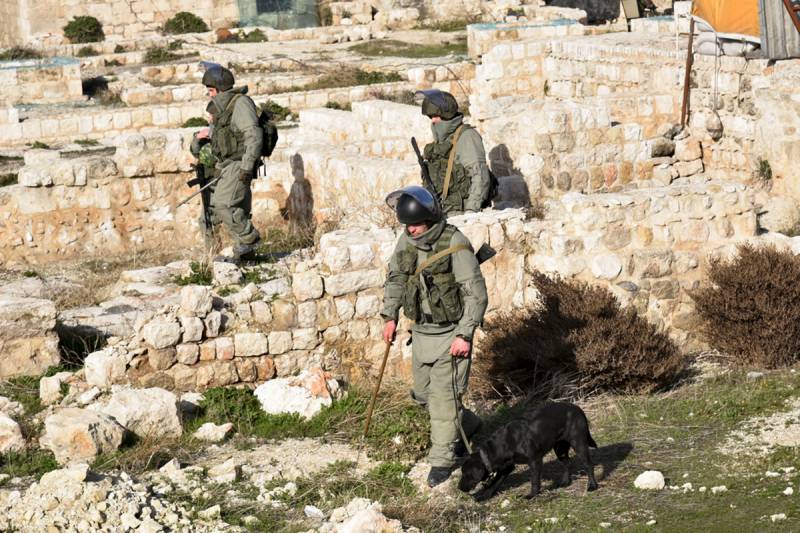The most famous sapper rat in history
On January 12, 2022, APOPO, an organization that specializes in training Gambian hamster rats, announced the death of its famous representative, the Magawa rat, which celebrated its 8th birthday last November.
The brave rodent, who worked for the benefit of the people in Cambodia for many years, searching for mines and unexploded ordnance, died peacefully on an honorable pension.
Over the years of its service, the smart animal has helped people find 71 anti-personnel mines and dozens of unexploded ordnance.
The long civil war in Cambodia has left millions of mines and a huge amount of unexploded ordnance in the land of this country. It is believed that up to six million more mines may remain in the country, which pose a threat to the life and health of children and adults. In their search for sappers today, our smaller brothers are also actively helping.
Magawa - winner of the gold medal for bravery
Magawa is by far the most famous sapper rat in the world.
This is the best rodent that the Belgian NGO APOPO (short for Anti-Persoonsmijnen Ontmijnende Product Ontwikkeling) has managed to produce. The organization specializes in training Gambian hamster rats, teaching them to search for and detect anti-personnel mines and ammunition, as well as tuberculosis bacilli.
Magawa is a male Gambian hamster rat. Like many of his kin trained by APOPO, he completed a year-long training course in Tanzania but did not stay in Africa. Most of the sapper rats, which are trained with the help of the Belgian organization, remain to work on the African continent, mainly in Tanzania and Mozambique.
Magawa was born and raised in Tanzania. Outwardly, this is an absolutely average representative of its species, but fate has prepared for him an amazing life that is inaccessible to most rats.
Magawa weighed 1,2 kg with a length of 70 cm. Of course, the animal was much larger than ordinary rats, but for Gambian rats these are normal values. Gambian hamster rats can grow up to 90 cm in length and weigh up to 1,5 kg, making them the largest members of the murine family.
Magawa spent most of his life in Cambodia helping the Cambodian Demining Center to find mines.
A rat covered an area the size of a tennis court in about 30 minutes.
Usually Magawa went to work in the morning, and his work shifts were just limited to a half-hour marathon. It is believed that during his service, Magava helped to check and clear an area of more than 141 square meters of mines and shells.
During the service, the sapper rat found 71 mines and several dozen unexploded ordnance.
For his services, Magawa was awarded by the British charitable organization PDSA, which since 1943 has been giving awards to animals that have particularly distinguished themselves in military affairs.
Magawa became the first rat to receive a gold medal for bravery from this organization in 2020, having given all the previous three dozen PDSA awards to dogs.
The head of the PDSA organization noted that the work of the sapper rat directly saves the lives of men, women and children who are forced to live surrounded by millions of mines left after the war. Each find of Magawa was a guarantee that the locals would not receive various injuries and would remain alive.
Magawa was in the service until the age of 7, until last year he retired with the status of a national hero of Cambodia and became world famous.
7 years for a rat is an honorable age, besides, during his service he injured his paw, ceasing to be as lively as before.
Minesweeper rat handler Malene noted that Magawa was an unsurpassed and talented member of his species. Despite its small size, it helped save many lives.
After retiring in June 2021, Magawa celebrated his 8th birthday in November, which turned out to be the last for the rodent. The animal met an honorary pension surrounded by love and care of Cambodian sappers in its own enclosure, spending time sleeping and playing and eating plenty of peanuts and bananas.
How sapper rats are trained
Sapper rats are currently being trained by the Belgian non-governmental organization APOPO as part of their HeroRATs program (hero rats).
The program started in 1997 in Belgium and after the first success was scaled to Africa, where since 2000 the headquarters of the organization (Tanzania) has been located.
Sapper rats trained under the program have discovered more than 1 mines in Mozambique, having already returned an area of 500 million square meters to the inhabitants of the country.
It is no coincidence that the Belgians stopped their choice on the Gambian hamster rat.
This animal is nocturnal, so it cannot boast of good eyesight. Nature compensated for this deficiency with excellent hearing and smell. It is the excellent sense of smell that is the main factor of choice, it turned out that rats are able to smell even the residual traces of explosives.
During the year they are trained to find explosives by smell, and they are also able to smell and recognize tuberculosis patients. Training usually begins at two months of age.
Not all rats turn out to be capable and receptive to training; “C”s are not allowed to search for real mines. Perhaps it is they who are further trained in a much less dangerous medical unit.

In favor of the choice of rats was the fact that Africa is their home, rodents are perfectly adapted to the hot climate, they are quite hardy and resistant to diseases.
An important factor is the cost of training, which is several times lower compared to training a service dog.
The costs of maintaining a small animal are also incomparable. For not the richest countries, this is of great importance. At the same time, Gambian hamster rats are omnivorous and not picky about food.
In addition to being highly sensitive to odors, rats have another advantage.
They weigh relatively little, which virtually eliminates the possibility of detonation even on sensitive anti-personnel mines.
During the year, the rats are trained to smell explosives, with each success accompanied by a tasty treat, such as a slice of banana.
Having memorized the smell of the chemical compounds that make up the explosive, the rat does not react to extraneous odors, such as the smell of metal.
Thanks to these small four-legged helpers, the process of finding mines is much faster. Having found an object that contains explosives, the rat begins to scrape the ground in this place with its paw, attracting the attention of sappers working with it on the same team.
The main assistants of sappers are still dogs
Most often, sappers' assistants are animals more familiar to us. First of all, they are service dogs.
In the USSR, service dog breeding originated in 1924. During the Great Patriotic War alone, more than 68 service dogs and 32 counselors were trained in our country. Among the trained four-legged friends of man there were a large number of mine-detecting dogs. It is believed that with their help, Soviet sappers found and discovered more than 4 million mines.
Service mine detection dogs are used everywhere today, despite the development and increasing introduction of sapper robotics. But even modern Robots unable to force the four-legged friends of man out of service. It's all about the unique canine scent. The sensitivity of a dog's nose is tens of thousands of times greater than the ability of the average person to smell.
Attempts to develop devices that could partially or completely replace the nose of a dog, or at least a person, are constantly being made. But a mass device that would surpass the unique mechanism created by nature itself has not yet been invented. And that means that there is still work for sappers' dogs.
Modern mine detectors react to metal, and it is not always a sign of the presence of explosive devices. In turn, service dogs are looking for the explosive itself, which can be the basis of an improvised shellless explosive device or be in ammunition, the body of which is made of wood or plastic.
According to statistics, well-trained mine detection dogs are able to find a mine 3-4 times faster than a human.
It is no coincidence that, in addition to modern robotics, Russian engineering troops also actively used four-legged friends when clearing Syrian Palmyra.
Service dogs, primarily German Shepherds and Labradors, worked on a par with people in difficult climatic conditions. Dogs helped to find even the most unusual explosive devices that could be disguised in ordinary civilian items: household appliances, books and even toys.




Information